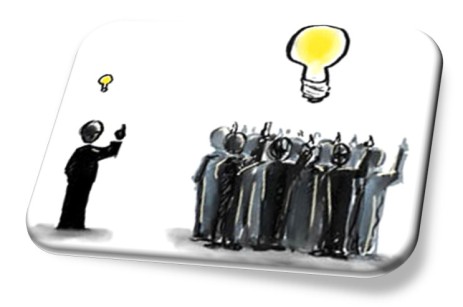
Imagie via mrsmart.wordpress.com
What exactly is a crowd? Wikipedia says it’s “a large and definable group of people,” underlining that it’s a different concept than the mob (the so-called lower orders of people in general) or the masses (everybody in the context of general public). This post is not about the concept of the crowd in general, but about an academic paper that examined how the sociological concept of the crowd evolved over time. In Reconfiguring the sociology of the crowd: Exploring crowdsourcing, Mark N. Wexler from Simon Fraser University (Vancouver, Canada) discusses the way in which the crowdsourcing trend reconfigures the classical sociological treatment of the crowd.
The purpose of the paper is to examine how the contemporary literature on crowdsourcing recasts the classical social scientific conception of the crowd from social problem to problem solver (Wexler, 2011)
He describes three phases: the mad crowd as a social problem, the protesting crowd as (another type of) social problem… and finally the “wise” crowd as a problem-solver.

In phase one, Wexler describes the crowd as a social problem generator, as a group of people which are threatening or challenging the social order. As these crowds “created a power vacuum,” and their members were seen as deviant, control was necessary to manage them. Wexler references European socialogogists like Tarde (1890), Sighele (1892) or Le Bon (1895), whose point of view “aid the elite” by “[emphasizing] the madness of crowds,” he says.
[The crowd’s collective intelligence] generates rather than solves problems. The elite seek knowledge on how to control and manage the problems generated by the crowd

In phase two, he crowd is still seen as a problem generator, but as a rational one. “The second wave of sociologists [depict the crowd] as manifesting rationality-in-context,” says Wexler, citing authors such as Turner and Killian (1957), Park (1972), McClelland (1989) or McPhail (1991). The crowd is still seen as a large number of people that causes social problems, but they do it with a purpose, not out of sheer madness. They do it to protest against establishement, to “test the bounds of the established elite,” Wexler explains, which also causes trouble.
The idealism and egalitarianism of the crowd is the occasion for social, economic and political problems

In phase three, which is today, the crowd is seen for the first time as a problem solver. Today, “a crowd is understood as those who respond and get involved with a mass call for participants,” says Wexler, who also underlines that the idea of crowd-sourcing has existed for centuries (the Longitude Prize in Britain, the invention of Margarine in France, the Wanted posters in the Wild West…). Recent authors like Surowiecki (2004), Howe (2006) or Brabham (forthcoming) have described and shaped this new view according to which the collective intelligence of the crowds can generate useful ideas.
The crowd is collectively intelligent and can, when managed, solve problems
One example Wexler provides is the use of creative crowdsourcing i.e. how L’Oréal used Current TV, and its Viewer-Created Ad Messages (VCAM) program, to create advertising in an innovative way. In Spring 2006, L’Oréal Paris launched a video contest on Current TV’s VCAM network, asking people to create an ad about the topic of color. The winning entry, called “Geisha” was created by a user called “spicytuna” who was rewarded with 1,000$ by the French luxury company. To my knowledge, this is the very first crowdsourced video contest by a big brand – even before the term crowdsourcing appeared!
At the end of his paper, Wexler describes the crowdsourcing process as a five-stage process, from the decision to use crowdsourcing in the first place (stage 1) to the decision about subsequent use of crowdsourcing (stage 5). He also discusses his findings. One of his observations is that in the two first phases of crowd sociology, the elite is always separated from the crowd… while in the third one does “not recognize the crowdsourcer as either an elite group or those doing
the elite’s business,” which leads him to affirm that:
The result of crowdsourcing is a form of co-creation [in which] the crowdsourcer champions rather than opposes the crowd
But is this true? Brabham already underlined that the amateurship of the members of the crowd is a myth, so is it right to talk about equality between the crowd’s members and the crowd’s organizers? Isn’t there still an elite? There is! “The new elite advances crowdsourcing as either a grass roots form of free market […] or an open, transparent community of voluntary knowledge workers […] giving freely of their talents for a good cause,” Wexler says. This paper raises some interesting questions, and I hope it will spur some discussions about crowdsourcing as a way to solve problems, and as a viable form of organization in the future. Wexler says that the current debate about crowdsourcing is “a rosy one” in which advocates defend the value of this distributed method for problem-solving. Very few people have a critical discourse about the phenomenon…
This paper invites social scientists and more specifically sociologists to monitor and get involved with phase three crowd theorizing…
… says Wexler. I’m looking forward to read more about this topic. For a first interesting read, I invite you to have a look at The Dangers of Crowdsourcing.
